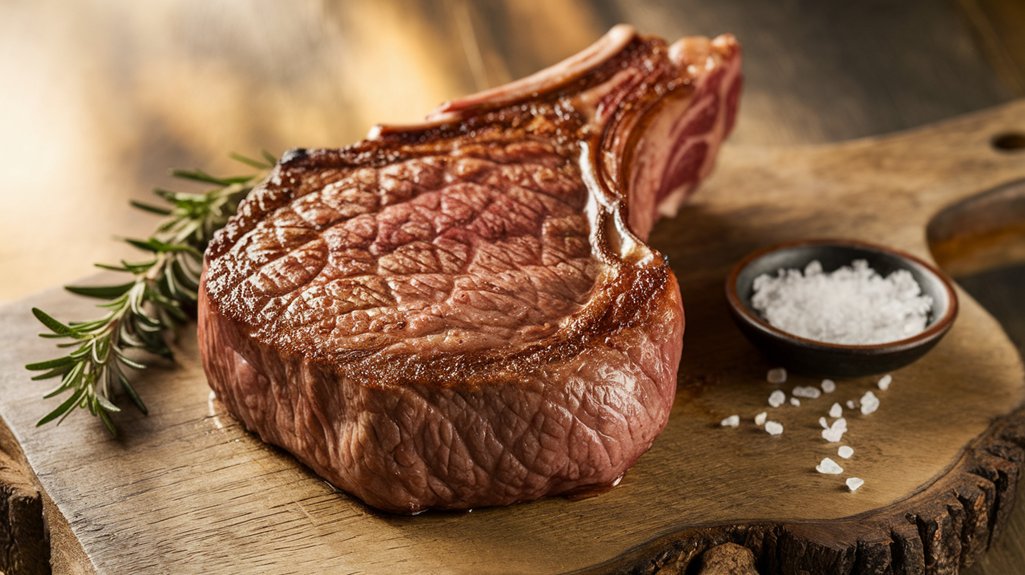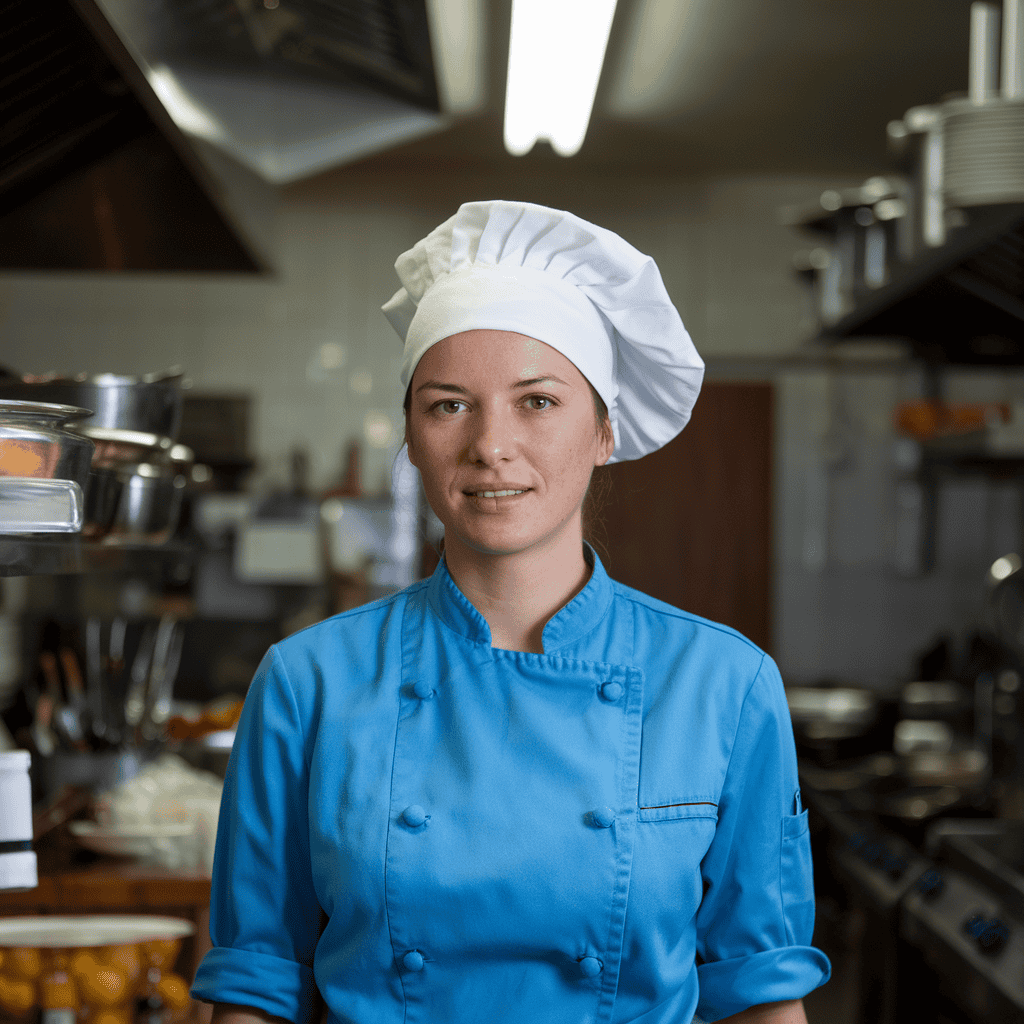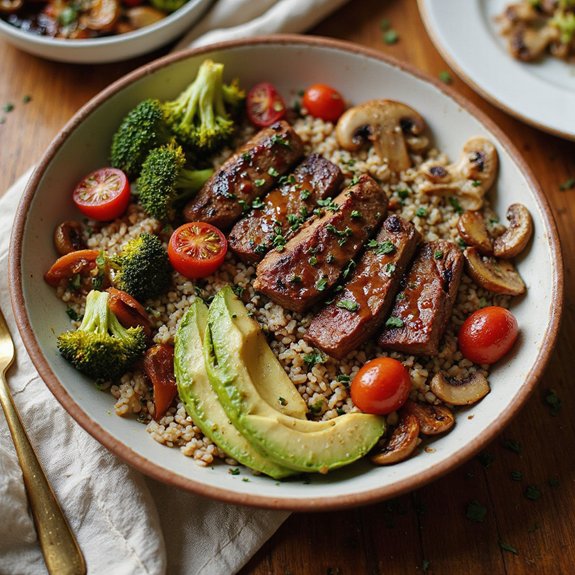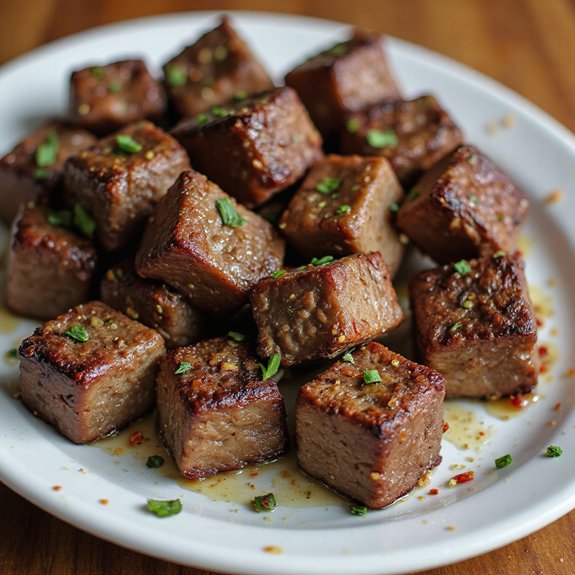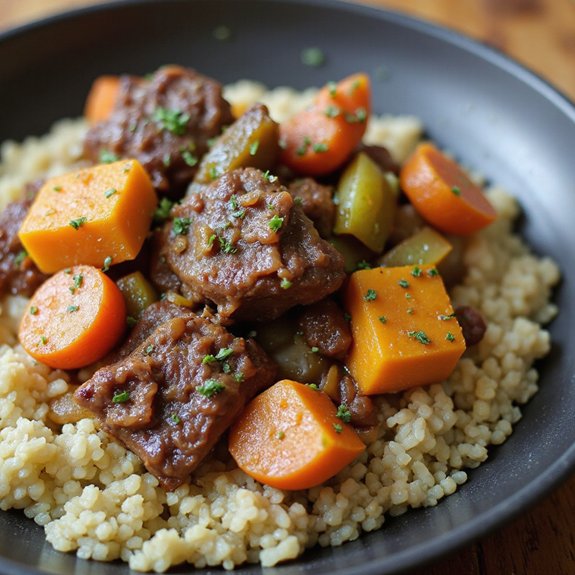When you think of a ribeye steak, imagine a cut bursting with flavor and tenderness, thanks to its marbling.
The fat content is what sets it apart, melting during cooking to create a juicy, savory crust.
Whether you’re grilling or pan-searing, the method brings out its bold taste, complementing a variety of sides.
Season it right, and you’ve got a restaurant-quality dish that elevates any meal. But there’s more to mastering this classic…
Kitchen Tools Required
- 1 Cast iron skillet or heavy-duty pan
- 1 Pair of tongs
- 1 Meat thermometer
- 1 Cutting board
- 1 Sharp knife
Ingredients
- 2 Ribeye steaks, 1-inch thick
- 2 tablespoons olive oil
- 1 teaspoon salt
- 1/2 teaspoon black pepper, freshly ground
- 2 cloves garlic, crushed
- 2 sprigs fresh rosemary
- 2 tablespoons unsalted butter
Cook & Prep Time
To efficiently manage your time while preparing and cooking a perfectly seared ribeye steak, follow this timeline:
Preparation (Total: 40 minutes)
- Room Temperature Rest:
- 0:00 – 30:00: Remove the ribeye steaks from the refrigerator and let them rest at room temperature for 30 minutes. This step guarantees even cooking.
Cooking (Total: 10 minutes)
2. Preheating the Skillet:
– 30:00 – 35:00: Preheat your cast iron skillet over medium-high heat for about 5 minutes until it’s very hot.
3. Seasoning & Searing:
- 35:00 – 37:00: Pat the steaks dry with paper towels and generously season both sides with salt and black pepper.
- 37:00 – 40:00: Add olive oil to the skillet, swirl to coat, and place the steaks in the skillet. Sear for 3-4 minutes without moving them.
4. Flipping & Basting****:
- 40:00 – 44:00: Flip the steaks and add crushed garlic, fresh rosemary, and unsalted butter to the skillet.
- Tilt the pan slightly and use a spoon to baste the steaks with the melted butter for another 3-4 minutes.
5. Checking Temperature & Resting:
- 44:00 – 45:00: Check the internal temperature using a meat thermometer; it should read 130°F for medium-rare.
- 45:00 – 50:00: Remove the steaks from the skillet and let them rest on a cutting board for 5 minutes to allow the juices to redistribute.
Final Steps
6. Slicing & Serving:
– 50:00 – 51:00: Slice the steaks against the grain and serve immediately.
Recipe
Ribeye steak is a popular choice for steak lovers, known for its rich flavor and marbling that contributes to its tenderness.
To prepare a perfectly seared ribeye, you need a few simple ingredients and a bit of patience to achieve the ideal crust and juicy interior.
This classic American dish is perfect for a special dinner or a weekend treat, and with the right technique, you can replicate a restaurant-quality steak in your own kitchen.
Begin by allowing the ribeye steaks to come to room temperature, which helps them cook more evenly.
A cast iron skillet is recommended for this recipe as it retains heat well and guarantees a good sear.
Season the steaks generously with salt and freshly ground black pepper before searing them in the skillet.
Adding garlic, rosemary, and butter not only enhances the flavor but also aids in achieving that mouth-watering crust on the steak.
Once the steaks have reached room temperature, preheat your skillet over medium-high heat.
Pat the steaks dry and season them with salt and pepper.
Add olive oil to the hot skillet and sear the steaks for 3-4 minutes on each side, making sure not to move them around.
After flipping, add garlic, rosemary, and butter, and baste the steaks with the melted butter.
For medium-rare, check that the internal temperature reaches 130°F before removing the steaks from the skillet.
Allow them to rest for 5 minutes before slicing against the grain and serving.
For the best results, confirm your skillet is adequately preheated to get the perfect sear, which helps lock in the juices.
The resting period is vital as it allows the juices to redistribute throughout the meat, resulting in a more flavorful and tender steak.
If you prefer a different doneness level, adjust the cooking times accordingly, and always remember to use a meat thermometer for accuracy.
Cooking Steps
Start by pulling your ribeye steaks from the fridge, allowing them to reach room temperature for ideal cooking.
Heat your cast iron skillet until it’s just shy of smoking, ensuring it’s hot enough to create that perfect sear.
Season the steaks generously with salt and freshly ground black pepper, add olive oil to the skillet, and lay the steaks in without moving them to develop a rich, flavorful crust.
Step 1. Bring Steaks to Room Temperature
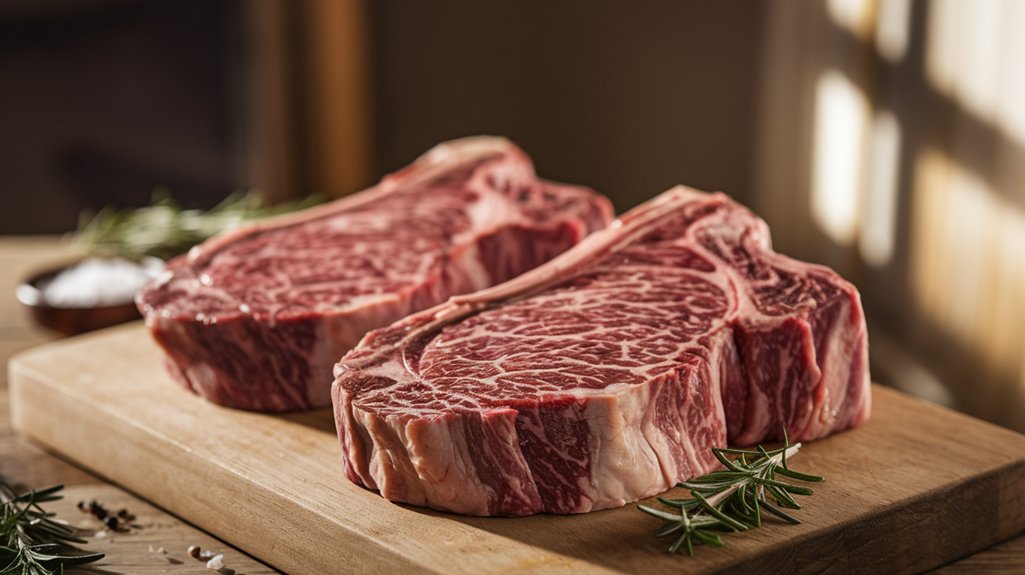
Before you begin cooking, allowing your ribeye steaks to come to room temperature is a critical step that guarantees even cooking.
Take the steaks out of the fridge about 30 minutes prior to cooking.
This waiting period lets the internal temperature rise, leading to a more uniform cook and a juicier bite.
| Time (minutes) | Action |
|---|---|
| 0 | Remove from fridge |
| 10 | Start seasoning |
| 20 | Preheat skillet |
| 30 | Steaks at room temp |
Season your steaks during this time to let the flavors penetrate.
A room-temperature steak sears more effectively, forming a savory crust while keeping the inside tender.
If they’re too cold, the exterior overcooks before the center reaches your desired doneness.
Patience here results in superior texture and flavor.
Step 2. Heat Skillet to Smoking Point

As you prepare to sear your ribeye steak, make sure your skillet reaches the smoking point, essential for achieving that perfect golden crust.
Choose a heavy-duty cast iron skillet, as it retains heat evenly, providing an ideal cooking surface.
Place the skillet over medium-high heat and watch closely.
You’ll know it’s ready when a faint smoke begins to rise and the surface shimmers, indicating that the oil’s breaking down just enough to create a non-stick layer.
This instant, intense heat sears the steak’s exterior, forming a caramelized crust that locks in juices and amplifies flavor.
Avoid overcrowding; instead, make certain each steak has ample room to breathe, maximizing heat contact.
A well-heated skillet is your secret weapon for steak perfection.
Step 3. Season Steaks With Salt, Pepper

With your skillet now perfectly heated, focus on the steaks themselves.
Begin by patting them dry thoroughly with paper towels.
This step is vital for achieving that mouth-watering crust.
Next, season each ribeye generously with salt and freshly ground black pepper.
The salt draws out moisture during cooking, forming a savory crust, while the pepper adds a subtle yet robust kick.
| Seasoning | Purpose | Effect on Flavor |
|---|---|---|
| Salt | Draws out moisture | Creates a savory crust |
| Pepper | Adds a subtle kick | Enhances robust flavor |
| Drying | Removes excess moisture | Guarantees a perfect sear |
Hold the steaks high above the board to let excess seasoning fall off, guaranteeing even coverage.
This simple yet essential step sets the stage for a perfectly seared ribeye.
Step 4. Add Olive Oil to Skillet
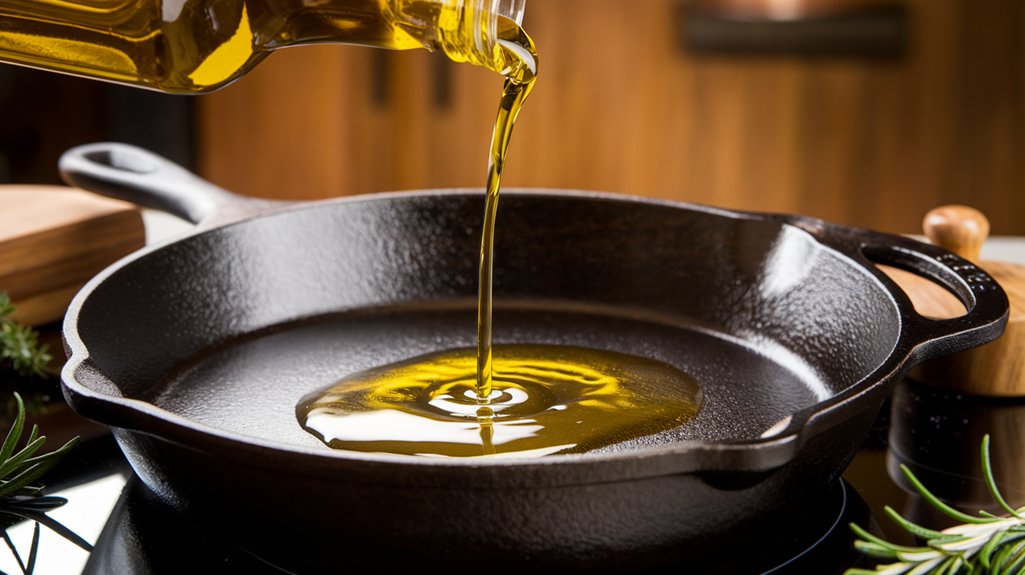
Drizzle olive oil into your preheated skillet, allowing the oil to glide across the surface and coat it evenly.
This thin layer of olive oil is vital not just for preventing the steak from sticking, but also for promoting a flawless, golden-brown crust.
As the oil heats, it will shimmer slightly, signaling that it’s ready to embrace the ribeye.
Make sure your skillet is hot enough before adding the oil—this step is significant for releasing the flavors and achieving that perfect sear.
The olive oil contributes subtle, fruity notes that complement the rich, marbled meat.
Keep an eye on the oil’s behavior; a gentle ripple suggests it’s just right for the steaks, setting the stage for a culinary masterpiece.
Step 5. Sear Steaks Without Moving

Once your skillet is shimmering with hot oil, it’s time to lay the ribeye steaks down with purpose.
Feel the sizzle as the meat meets the pan, creating an exquisite crust.
Resist the urge to move them; this is where the magic happens.
Allow the steaks to sear undisturbed for 3-4 minutes.
This stillness guarantees the Maillard reaction occurs, a chemical process that browns the surface, locking in flavor and moisture.
The key is patience—let the skillet do the work.
As the steaks sear, they’ll release naturally from the pan when ready, avoiding any tearing.
This method creates a perfect golden-brown crust, enhancing the steak’s inherent richness, setting the stage for what’s to come.
Serving Tips
- Garlic Mashed Potatoes: Creamy and flavorful, they pair perfectly with the rich taste of the steak.
- Grilled Asparagus: Adds a fresh, crunchy contrast to the tender steak.
- Caesar Salad: Offers a revitalizing, crisp side with a hint of tanginess.
- Roasted Brussels Sprouts: Their caramelized sweetness complements the savory steak.
- Buttered Corn on the Cob: A classic, simple side that enhances the meal’s comforting feel.
Storage/Freezing/Reheating
Storage: After cooking, store ribeye steak in an airtight container in the refrigerator for up to 3-4 days to maintain freshness and prevent bacterial growth.
Freezing: Wrap the cooked ribeye steak tightly in plastic wrap or aluminum foil, then place it in a freezer-safe bag or container to freeze for up to 2-3 months.
Reheating: To reheat, use a low oven temperature (around 250°F) or a skillet over low heat to gently warm the steak without drying it out, maintaining its juicy texture.
Final Thoughts
Although mastering the art of cooking a perfectly seared ribeye steak may seem challenging, it’s truly about understanding your ingredients and technique.
Start with a well-marbled ribeye; this guarantees rich flavor and tenderness.
Preheat your cast iron skillet thoroughly to achieve that coveted crust.
When seasoning, be generous with salt and freshly ground black pepper to enhance the steak’s natural flavors.
The key is in the sear—let the steak develop a caramelized exterior by leaving it undisturbed in the pan.
Don’t forget the aromatic infusion of garlic and rosemary to elevate the taste profile.
Finally, let it rest; this step is non-negotiable as it reabsorbs the juices, assuring each slice is succulent.
Enjoy the complexity of flavors with every bite.
Frequently Asked Questions
What Is the Nutritional Value of a Ribeye Steak?
You’re curious about the nutritional value. A typical 3-ounce serving packs about 240 calories, 18g of fat, and 22g of protein. It offers a rich flavor profile, delivering essential nutrients like iron, zinc, and B-vitamins.
How Can I Choose the Best Ribeye Steak at the Store?
When you’re choosing the best steak, look for even marbling, a bright red color, and firm texture. Opt for USDA Prime or Choice grades for top quality. Freshness is key—check the sell-by date for assurance.
What Is the Difference Between Ribeye and Other Steak Cuts?
You’ll notice ribeye’s marbling gives it a juicy, rich flavor, unlike leaner cuts like sirloin. The ribeye’s fat melts during cooking, enhancing its tenderness, while other cuts may require different techniques to achieve similar results.
Can Ribeye Steak Be Cooked on a Grill Instead?
You can definitely grill it. Make sure your grill’s preheated to high heat. Season well, sear each side for 4-5 minutes, then rest. Grilling imparts a smoky flavor while maintaining the steak’s juiciness and tenderness.
How Do I Properly Store Uncooked Ribeye Steak?
Store uncooked steak by tightly wrapping it in plastic wrap, then placing it in an airtight container. Keep it in the coldest part of your fridge, ideally at 32°F, to maintain freshness and prevent spoilage before cooking.

Ribeye Steak
Equipment
- 1 Cast iron skillet or heavy-duty pan
- 1 pair of tongs
- 1 Meat thermometer
- 1 Cutting board
- 1 sharp knife
Ingredients
- 2 Ribeye steaks 1-inch thick
- 2 tablespoons olive oil
- 1 teaspoon salt
- 1/2 teaspoon black pepper freshly ground
- 2 cloves garlic crushed
- 2 sprigs fresh rosemary
- 2 tablespoons unsalted butter
Instructions
- Remove the ribeye steaks from the refrigerator and let them come to room temperature for about 30 minutes.
- Preheat your cast iron skillet over medium-high heat until it is very hot.
- Pat the steaks dry with paper towels and season both sides generously with salt and black pepper.
- Add olive oil to the skillet and swirl to coat the pan.
- Place the steaks in the skillet and sear for 3-4 minutes without moving them.
- Flip the steaks and add garlic, rosemary, and butter to the skillet.
- Tilt the pan slightly and use a spoon to baste the steaks with the melted butter for another 3-4 minutes.
- Check the internal temperature with a meat thermometer; it should read 130°F for medium-rare.
- Remove the steaks from the skillet and let them rest on a cutting board for 5 minutes.
- Slice the steaks against the grain and serve immediately.

